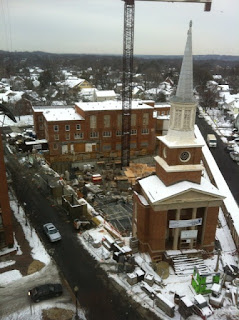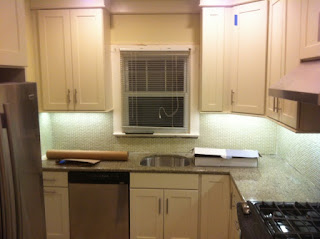One of the attractions of the town of Kamakura is its history as the Shogun capital of Japan, which it was from 1192 to 1333. All the ancient shrines, temples and gardens originated because of this wealth. After my visit to the Hase-dera Shrine and Daibutsu, I walked through the town for a half mile or so over to Tsurugaoka Hachiman-gu, which my guidebooks refer to as Kamakura's premier shrine, dedicated to the god of war.
I had made what I considered an early start getting down to Kamakura because of the two train transfers that would be required. I entered the grounds of Hase-dera at around 11 am, but even so, there was a growing crowd of visitors. At Daibutsu, the crowds had continued to grow. By the time I was at Hachiman-gu, as the picture shows, things were bustling.
Partly because of the crowd, I wasn't very tuned in to waypoints and interpretive signage at this temple. I just sort of made my way around, taking in the impressive grounds and buildings, and picking up snatches of what I was seeing as the opportunity presented itself.
After I had toured the little museum here, I learned about the Assassin's Tree, a 1,000 year old ginkgo that had stood on these grounds - meaning the tree would already have been more than 100 years old at the time of the shogunate. The story goes that a nephew of the ruling shogun lept from near the tree and killed him, only to be beheaded himself within a few hours. This brought an end to that ruling line in 1219.
The tree fell in a snow storm in March 2010 - we see old trees, much younger than this one, falling down in the DC area during storms like this all the time. This summer, they had signs of life out of the remaining stump, and a section of the old tree has been rooted there in the hopes it will come back. Meanwhile, there is a section of the trunk (showing that the core had rotted out from age) and a branch on display at the museum. The large branch, approximately a foot in diameter and nearly eight feet long, rests in a casket-like glass case with one end on a silk pillow.
As with the other shrines I visited, the crowds were here to make their first visits of the new year, I guess. There is the tradition of making new year's wishes on
emma, small wooden plaques with an image of whichever year it is (this year, the rabbit), which are then displayed at the temple. Also, there is fortune telling, where the fortune is written on a small scroll, and then hung on little ropes at various places around the temple. Since archery is still practice at this site, arrows are also sold, which I'm told are good luck charms for little boys.
Wikipedia has an excellent article about the temple at
http://en.wikipedia.org/wiki/Tsurugaoka_Hachiman-g%C5%AB. There is a lot that I saw there and simply can't write up in this post. There is a photo of the fantastic ginkgo tree with that article.
Getting back to my walk up to the temple, once I was in Kamakura proper the crowds really picked up, especially as I approached the main train station. There are three torii here along an approach that extends nearly 2 kilometers down to the sea. In a raised median, there is a pedestrian trail called the
dankazura, probably wide enough to walk 5 abreast and bordered on both sides by cherry trees. The design of this approach forces reverence to the shrine ahead and the place of worship.
One item I have forgotten to note in these last three posts is the ritual surrounding water features that stand at the entry way to shrines like these. There is a tradition of offering cold, clear, fresh water to wash your hands and mouth before entering the grounds. Upon first encountering one of these, I stood back and watched how it was done before trying it myself.
Basically, this act, called
temizu, works like this: wash the left hand first, then the right. Some people rinsed their mouths with the water, but I understand that they were not drinking the water. At some shrines, people will also wash their feet. Some folks finished this little ritual by tipping the ladle backwards to wash the handle, and then placing the ladle back on the rack with the opening down, always careful not to put any water back in the well. I have a photo here of the
temizu fountain that was at the Hase-dera shrine.
My next post will be the last from the Japan trip. After that one is up next week, I'll catch things up with the kitchen remodel, and also will have a hike to report.
 A quick thought this morning, it's been three years since I started watching all the construction in my work neighborghood. While one of the original three buildings is substantially completed - it even looks to be occupied on some of the office floors, the North Block building is still in the works, and of course, the church building is very much in the early stages.
A quick thought this morning, it's been three years since I started watching all the construction in my work neighborghood. While one of the original three buildings is substantially completed - it even looks to be occupied on some of the office floors, the North Block building is still in the works, and of course, the church building is very much in the early stages.















































